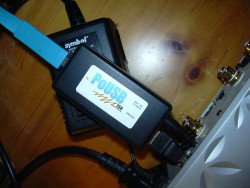fourwed
Head-Fier
- Joined
- Feb 13, 2010
- Posts
- 94
- Likes
- 11
Quote:
Yes, I agree with you that it sounds digital, or fatigue as JulienM said, that is why I switched it back to stock. However, I did not try it after I use lithium battery. I should give it a try later.
Quote:
The new DI should be better but still, a good power source and power isolation should make a difference.
Quote:
Oh, I thought you are using this kind of linear power supply. I am thinking how good is it compared to lithium battery.

Also, I purchased this USB isolator from a local online store. I must use a power source with it but its sound is not good even I use lithium battery to power this. I think it might be because of its power regulation and I will try to feed a 5V directly to it.

Do you know if this is the case for the DI-V2?
Which Adum4160 dongle are you using now with the dual psu inputs? Sounds interesting.
Right around here: http://www.head-fi.org/t/500369/audio-gd-digital-interface/2625#post_7859266
You need 74VHC04N or 74AHC04N or similar to replace the hex inverter chip in the di. I believe I'm using the 74VHC04N in mine.
I forgot to answer you before about this: I have only tried the 74VHC04N and the stock, I didn't get different variations to swap out. The biggest negative of the hex inverter swap is the sound can be a little more 'digital' (slightly harsh highs) but I found it was remedied completely by the isolator and using a good quality USB cable (I love monoprice, but their usb cable didn't seem very good for this purpose). The improvements in detail, soundstage, etc. are totally worth it though in my opinion, and the isolator is pretty much a must if you want the best sound quality.
Yes, I agree with you that it sounds digital, or fatigue as JulienM said, that is why I switched it back to stock. However, I did not try it after I use lithium battery. I should give it a try later.
Quote:
Yeah, I got the ACR based on recommendations on audiogon. I have the version 2 which isolates the data and power within the same cable, but the haven't tried the version 3 which splits the power and data across separate cables. Compared to some generic USB, the sound was a bit more clear and the bass seemed to extended deeper with the ACR. However, there are so many variables just on the USB section of my system, its hard tell what is improving what anymore.
I've only been able to compare the 74AHC04N and 74AHCU04N so far, and they sounded the same to me. I believe the latter is just the unbuffered version of the same chip. Both inverters added more instrument separation and spatiousness compared to stock, making the music a bit less congested. The stock sounded a bit more warm and smooth to me. I haven't been able to compare to the 74VHC04N yet.
I also have the DI-DSP on the way, and agree that all these little tweaks to the old DI may be irrelevant if the new DSP is better sounding in its stock form. Can't wait for the comparisons!
The new DI should be better but still, a good power source and power isolation should make a difference.
Quote:
I don't see any change in that section of the PCB.
http://www.poscope.com/pousbiso
It's a dead simple PCB with the 4160 chip, a 150mV ripple 400mA(including the device side of 4160, so more like 300mA for the device itself) power isolator and some diodes to force the use of the unregulated external input.
I've tried it w/ three types of PSU's:
-the built-in 150mV power isolator, that sounds nasty and colored to death.
-a 5.25V idle/500mA SONY cellphone wallwart, better SQ than either the computer 5V or the built-in power isolator
-a 5V/1A linear regulated PSU:
stunning SQ!
IME and IMHO, all those 4160 isolators that either use a very high ripple power isolator or a SMPS regulated input only give you a glimpse of what 4160 can offer. My next challenge is to use another of those linear PSU's in order to feed the HOST side of 4160, but that's a lot more complicated..
jkeny has been recommending this cable on many audiophile forums: http://shop.meconet.de/product_info.php?language=en&products_id=115485
but he has never tried it himself, huh...I'm not looking for thrills as a friend of mine tried a few tricks himself w/ USB power and all he managed to do is frying his USB controller
The problem w/ this kind of trick is that you need to share grounds but you still want to block the nasty computer +5V and replace it seamlessly.
Oh, I thought you are using this kind of linear power supply. I am thinking how good is it compared to lithium battery.
Also, I purchased this USB isolator from a local online store. I must use a power source with it but its sound is not good even I use lithium battery to power this. I think it might be because of its power regulation and I will try to feed a 5V directly to it.























 .
. 